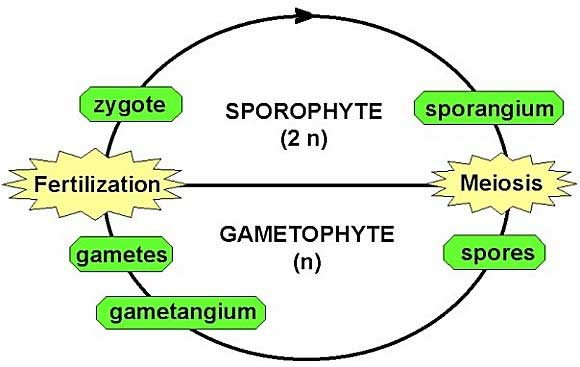How Do Plants Differ?
To summarize the sequence of the major events in the life histories of plants, we can use the stylized diagram that is below the following terms.
- sporophyte: diploid plant that produces spores through meiosis
- sporangium (-a): structure on a plant where meiosis occurs and spores are produced
- spore: haploid meiotic product in plants, the first cell in the gametophytic generation of plants
- gametophyte: haploid plant that develops from a spore, produces gametes
- gametangium (-a): structure on a gametophyte that produces gametes
- antheridium (-a): gametangium that produces male gametes (sperm)
- archegonium (-a): gametangium that produces female gametes (eggs)
- meiosis: division that produces cells with nuclei with the haploid chromosome number from a diploid cell
- fertilization: the fusion of gametes and their nuclei to form a zygote
- zygote: a fertilized egg, the first cell in the sporophytic generation of plants

This diagram is generally considered to depict the "life cycle" of a plant. By using the term "life cycle," we are looking at how a plant starts out at one point, such as the zygote, and goes through a developmental sequence that eventually gets the plant to a stage where it contributes to the formation of new plants that are at the same stage of development from which the original plant started.
Using the pea plant as an example, it started when an egg was fertilized by a sperm to form the diploid zygote. The zygote divided mitotically to form two cells; those two cells divided to form four cells; those four divided to form eight, and so on and so forth until we could see a multicellular plant that we recognize as a pea plant with roots, stem, leaves, and flowers. This is the sporophyte, with each cell containing the 2n number of chromosomes. For the pea this is 14. We will look at the next things that happen in more detail in the reading about the flowering plants (link in the list below), but for now we want to note that in the flowers are the sporangia. The sporangia contain cells that go through meiosis to produce spores. The spores develop into microscopic, haploid plants, the gametophytes. The gametophytes produce the eggs and sperm, which will fuse to form a new zygote. We have just completed the life cycle of a pea plant!
The readings about plants with links below include details of the life cycles of the major groups of plants. As you go through the readings and see how sexual reproduction is similar, yet different, for the different groups, you hopefully will gain a better understanding of the importance of well-known plant structures such as flowers.
For a more advanced treatment of the terminology used in plant sexuality and reproduction, visit Plant Sexuality at The Free Dictionary.